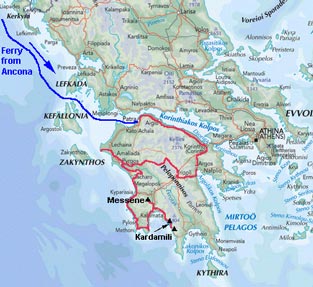 OUR GREEK ODYSSEY - Week
5
OUR GREEK ODYSSEY - Week
5
Week 5 Photos Bottom of page
Return to Index-page
|
And this is where we moved on to from Pylos, to wild-camp at around 2000 feet on Mount Ithome, just inside a section of the extant defensive walls and look-out towers of ancient Messene, safe from marauding Spartans. With a perfect clear night, bright sun the following morning, and such an amazing setting, it was certainly one of the most memorable camps ever. We felt we ought to have done an hour's sentry duty on the walls before breakfast, but instead, we settled for an exploration of the fortifications. Photo 1 shows the walls and watch towers sloping down the hillside, with George parked at the spot we camped. Excavations at Messene are progressively uncovering increasing areas of the former city's public buildings, and we spent a peaceful afternoon exploring the fascinating archaeological site, with the modern village of Mavromati nestling above us around a fold of Mount Ithome. But conscious of the drive ahead of us, we set off southwards to the Mani, the wild mountainous central peninsula of the south Peloponnese. The first challenge was negotiating our way through Kalamata, Messinia's capital city famous for its olives. We were thankful to emerge safely on the southern side for the drive down the Mani peninsula, over the narrow mountain road, made more dramatic by the daft driving habits of Kalamatans returning at breakneck speeds after a Sunday afternoon out in the Mani. Down the final hairpins, we descended to the delightful coastal village of Kardamili, and our campsite, Ta Delfinia, a further 5 kms further south. A kindly description of the place would be 'straightforwardly rustic'. But however basic, the facilities were clean and we had the place to ourselves, in perfect peace with just birdsong and the distant sound of surf on the shingle beach below for company - a delightful camp setting in an olive grove (see photo 2). Midweek, we moved closer to Kardamili, with plans to walk parts of the Viros Gorge which curves dramatically up into the western Taigetos range, the mountainous central spine of the Mani peninsula. But the weather had different plans, and by late afternoon, a brisk southerly gale was blowing. The campsite was beyond the village, 2 kms along a narrow lane running by the shore. As we drove along, a huge sea was raging. Fortunately the campsite was well sheltered with olive trees, but the shoreline below was pounded with towering breakers crashing over the rocks. That night we also had the spectacle of a lunar eclipse; perhaps this was another omen. The following day, we had an exploratory venture into the mountainous hinterland, and looking down on the coast, the gale-driven stormy sea was worsening (see photo 3). Our evening walk back along the shore-line lane to camp showed the extent of the devastation caused by the storm. The lane was covered with rocks and boulders hurled across from the shore, and blocks of concrete ripped away by the huge waves. Vegetation had been shredded and sections of tarmac had been uplifted and washed away, leaving gaping holes. There was clearly no way that night that any vehicle was going to get back to the village. We were trapped at the campsite, but at least were secure with food, water and power for several days if need be, and the campsite was safely above sea-level. All that night the storm continued to rage, and morning showed the extent of the devastation around the coastal areas of southern Greece. Kalamata had taken a severe pounding with much destruction around the waterfront areas. Local newspapers headlined 'The Catastrophe', but ironically there was no mention in the Greek nationals - if it doesn't happen in Athens, it doesn't happen at all! Fortunately the following morning dawned clearer, the wind eased and swung round to the west, and the seas began to subside. Also, to our surprised relief, a road-scraper was already at work clearing away all the debris blocking the lane. The fine weather was perfect for our planned gorge walk up into the mightily impressive Viros Gorge. Even at this time of the year, the river bed was perfectly dry, with superb scrambling up though the boulders and massive limestone cliffs towering up on either side. The most impressive section of the gorge narrowed down to about 8 m, then opened out into upland meadows with an old monastery. The terrain was spectacular and the wild flora beyond text-book description. Sheila found a number of interesting specimens, including several different wild orchids, and the interesting parasitical plant shown in photo 4. This area is criss-crossed with cobbled former mule-tracks called kalderimi, beautifully engineered for ease of height gain, and we followed several of these to navigate our way back from a high mountain village to the coast at Kardamili. So far, this trip has way exceeded our expectations in satisfying our respective interests, particularly in history, wild-life, culture and politics and generally learning more about this fascinating country. Its ancient history provides the foundation of modern western civilisation and gives us the basis for modern political concepts like democracy itself. Yet because of its own unfortunate later history under Turkish domination, it is a country which missed out on the Renaissance and Enlightenment. The Greek mainland is a part of the Balkans, yet its climate and wild-life feel more Mediterranean. There is still so much for us to explore and to learn. Our Odyssey continues, and next week we cross the mighty Langhada Pass over the 7,000 feet Taigetos mountain range into Laconia, the country of ancient Sparta. Sheila and Paul Published: Sunday 9 May
|
 Week
5 news: Messene and The Mani
Week
5 news: Messene and The Mani